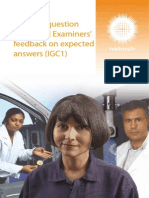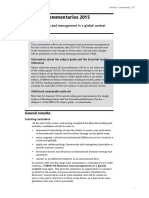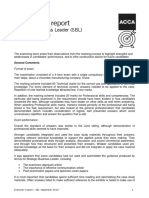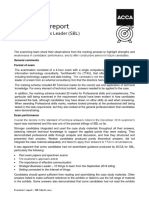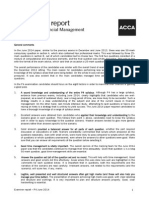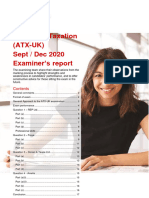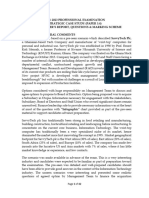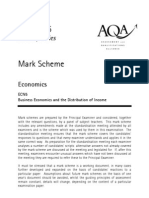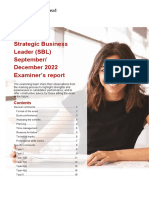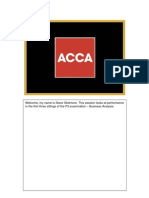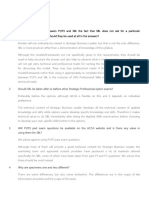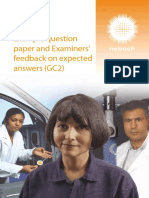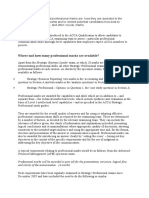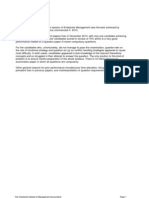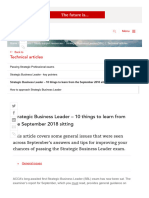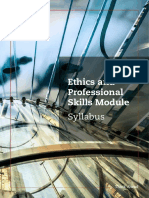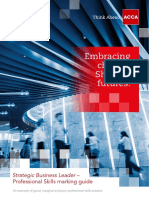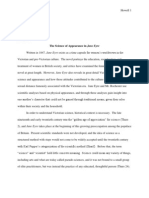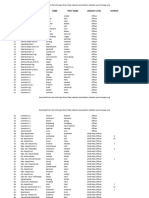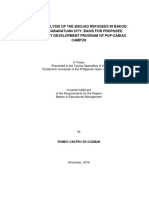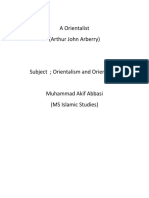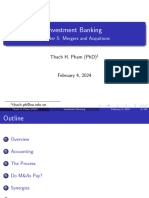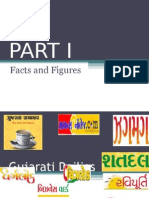SBL Examreport m19
SBL Examreport m19
Uploaded by
NebiyuCopyright:
Available Formats
SBL Examreport m19
SBL Examreport m19
Uploaded by
NebiyuOriginal Description:
Original Title
Copyright
Available Formats
Share this document
Did you find this document useful?
Is this content inappropriate?
Copyright:
Available Formats
SBL Examreport m19
SBL Examreport m19
Uploaded by
NebiyuCopyright:
Available Formats
Examiner’s report
Strategic Business Leader (SBL)
March 2019
The examining team share their observations from the marking process to
highlight strengths and weaknesses in candidates’ performance, and to offer
constructive advice for future candidates.
General Comments
Format of exam
The examination consisted of a 4-hour exam with a single compulsory section comprising 5 tasks
most with more than one element, about an international clothing retail company, SmartWear.
The marking scheme includes 80 technical marks for the correct use and application of technical
syllabus knowledge. For every element of technical content, answers need to be applied to the
case material. Simply regurgitating rote learned facts will not attract any marks at Strategic
Professional.
In addition, the marking scheme includes 20 marks for professional skills and competencies. The
particular skill being examined in the requirement should be evident in how candidates answer the
question, although candidates may draw on other skills as well when answering. When awarding
professional skills marks, markers will look primarily at the professional skill being tested in the
question requirement, but they will also look at the general professionalism that candidates are
demonstrating.
Exam performance
Stronger candidates both integrated and used the relevant case study exhibits throughout their
answers, as well as selecting appropriate syllabus knowledge to support the applied points they
were making. They demonstrated professional skills through analysis and discussion, and in how
they structured and presented their answers. Weaker candidates used pre-learned knowledge as
the basis for their answers and did not integrate or apply the case material adequately. It was
apparent that some candidates had neither read the guidance produced by ACCA nor worked
through the specimen examinations or the two previous exams set.
Candidates need to spend sufficient time reading and assimilating the case study material before
even contemplating answering the questions. The six exhibits:
Provide the material that directly underpins the applied points that candidates should be
making.
Include necessary background information and explanation to provide context for the answers.
Help candidates decide how to structure their answer
Highlight the most important issues that answers should cover
Unfortunately, some answers failed to make sufficient reference to the range of available material
or focused too much on one exhibit. Candidates should always read the exhibits with the
Examiner’s report – SBL March 2019 1
requirements of every question in mind, as this helps them identify which questions will be drawing
on the material in each exhibit. In this exam, for example, the briefing notes prepared by the
business development department for the consultant (Exhibit 1) provided information that was
relevant throughout the exam, particularly as the candidate played the role of the consultant.
Candidates must also spend sufficient time planning to ensure that their answers are:
structured logically;
balanced in terms of the depth of discussion required with the breadth of points to be made;
covering the most important points;
not padded out with superfluous waffle, as this just wastes time and scores no marks, and
avoiding unnecessary overlap and duplication, as marks are not awarded twice for the same
point.
Generally, candidates answered all five tasks, although there was some evidence of shortage of
time when answering their final task. It was also noticeable that the quality of some candidates’
answers tailed off towards the end of the exam, with indications that they either mismanaged their
allotted time or had run out of stamina. Candidates are strongly recommended to attempt mock
exams before the actual exam under full exam conditions, as this will help them to get used to the
challenging demands on concentration, thinking and writing that a four-hour exam makes.
Mostly candidates answered the questions in order. Where they did not, they appeared to be
leaving one question, which they liked least, till the end. Candidates whose answers were not in
the numerical order of the examination tended not to appreciate the implicit sequencing of events
in the case and so produced answers that were more theoretical/academic than professional.
Candidates are advised to answer the requirements in order, as some future exams may follow a
more developed timeline than this one, or have progressive and related question requirements.
In most cases, those candidates who failed the exam did so because of a lack of comprehension of
the questions, lack of analytical skills; failure to respond to exam questions in a
professional/commercial manner, and simply not understanding what the question asked them to
do. Some of the candidates who failed gave lengthy and over-elaborate answers which failed to
clearly articulate the relevant points required by the question.
Technical marks
To gain each Technical mark, candidates need to make points which:
Address the specific requirements of the question, considering the scope of answer required
and what the question verbs used indicates should be provided.
Apply to the organisation and its environment featured in the case study, in this case
SmartWear and clothing retail industry
Are specific to the decision or situation covered in the question
Show the reader/marker why the point they are making is significant in the circumstances
described.
Examiner’s report – SBL March 2019 2
A simple demonstration of technical knowledge or explanation of theory will not score marks in this
exam.
Weaker candidates saw trigger words such as <IR> Integrated Reporting and wrote all they knew
about the ‘6 Capitals’ without considering their application to the question requirements or
SmartWear’s current situation. Using a technical framework unnecessarily as the basis for
structuring an answer led many candidates into forcing their answer to fit the framework and,
crucially, providing an answer that was not in a form helpful to its recipient. In Q1a) it was evident
using the PESTEL framework was appropriate, however the material made no real reference to
environmental or legal issues, but despite this, many candidates dovetailed their answer to fit the
model. Candidates must appreciate that models and frameworks are never going to exactly fit the
answer in an SBL task, but they provide a good basis for generating relevant ideas and developing
answer into a suitable and easy to follow [and mark] structure.
Candidates often
just repeated the case material verbatim, which would not secure any marks, and,
did not answer the question set, e.g.Q4b), they failed to clearly indicate how the NPV analysis
supported the CDMS investment or question the underlying assumptions that were made in
supporting Exhibit 6.
Up to two technical marks are very often available for a well-developed point made. This can
include
evaluating how significant the points are;
using information provided that relates the point to SmartWear;
explaining the consequences to the company; and
supporting the points made with relevant examples from the case material.
Professional skills marks
Many candidates had clearly thought about professional skills marks and attempted to present their
answers in the appropriate format, tone or style, as requested in each requirement. However, there
were many instances where candidates paid absolutely no attention to the format required so
limited their scoring potential.
The format requested by the intended recipient will be supported by an answer that is presented
clearly with headers throughout the answer, short focussed sentences and with paragraphs of 3-4
sentences. Candidates also failed to consider the needs and situation of the target recipient, e.g.
using the same tone of answer for the company’s board [Q5a] and the finance team [Q5b].
Candidates need to explain points in ways that will enhance the understanding of the target
audience, and address clearly what the intended recipients as most interested in, which may be
specified in the case requirements or the exhibits.
Candidates should remember that they are carrying out a professional task that has a particular
purpose(s) for a defined user or stakeholder. This should simulate the normal professional working
Examiner’s report – SBL March 2019 3
environment that they are exposed to on a daily basis.
Further comments on specific professional skills, by question, are given below.
Specific comments
Question 1 a)
On the whole this question was reasonably well answered with many candidates scored highly,
and some achieving full marks. Most answers used the PESTEL model, some Porter’s Five
Forces, and a few SWOT. With the minority of candidates using all three, but by doing so the
answers were very long and repetitive. This approach took a disproportionate amount of time to
complete, with the result that their answers to Question 5 were often rushed and incomplete.
Most candidates picked up on the uncertain political environment, poor economy and growth of e-
commerce as being the main points of interest, and developed these satisfactorily. However, a few
issues arose with those candidates that did less well, and key problems included:
Including elements of the PESTEL framework, namely environmental and legal, that were not
referred to in the case material. In effect they attempted to fit an answer to the framework,
rather than the other way around.
Failing to link their observations to the mission, business model and strategic goals of
SmartWear, which was the whole point of the question.
Very long answers which included lengthy comparisons between the different locations in
which the company operates.
Heavy focus on internal decisions, e.g. the company is considering in investing in CDMS and
this would be beneficial because, etc.… [long explanation], at the expense of covering many of
the different issues emerging from the environment.
Straying into risks, and how they may be addressed which would be covered in part b)
Inclusion of long introductions giving a lot of background about the company taken directly from
the case material.
Future exam candidates are strongly advised to produce answers that are of a length proportionate
to the marks allocated to the question, and apportion their writing time between the questions
accordingly.
Question 1 b)
This was mostly answered fairly well with many of the candidates managing to identify several or
more of the key risks and offer sensible solutions. Most focussed on poor market conditions and
the lack of an e-commerce platform as risks to the business, with mitigation usually referring to
changing suppliers and starting to sell on line. However, some answers were quite general and did
not always refer specifically to SmartWear. A few good candidates drew from their Financial
Management knowledge and included foreign exchange risk and hedging to mitigate, which scored
well.
Examiner’s report – SBL March 2019 4
Many candidates adopted a tabular format to answer this question which allowed for more focused
answers. The table reduced the temptation to include unnecessary material and deterred
unnecessary repetition, and could be produced relatively quickly so was a good use of limited
answering time.
Key problems encountered in this question:
Straying into areas that are the topic of other requirements, e.g. too much focus on purchasing
issues that would be covered in question 3, and extensive discussion around big data and
CRM that would be covered in question 2 b)
Linked to this, is picking up on the less relevant risk areas and presenting them with a focus
that is not quite right, or struggling to clarify their thoughts in the way required by the question.
An example is when there seemed to be an awareness that there is a problem linked to
dominant suppliers, but rather than discussing this properly in context of the question and
suggesting a sensible solution there would instead be a lengthy discussion around many of the
issues with suppliers that would have been better placed in the answers to task 3
Over-reliance on the TARA framework without any real attempt at application, e.g. simply
stating that a particular risk should be ‘avoided’ but with no further explanation as to what
action might be taken to achieve this.
Producing the same or a very similar answer for both parts a) and part b). There was potential
to deal with similar issues drawn from the case material, as it came under the same task, but in
very different ways. Simply repeating 1 a) answers, which was evident on many scripts, scored
no marks.
Wholly inappropriate solutions, such as suggesting the company switches its strategic focus
and starts selling ‘luxury’ clothing because the low-cost model isn’t working in the recession.
Other suggestions such as the company diversifies to a more ‘essential’ product stream, such
as food, rather than clothing which no one will buy in a recession. Less extreme, but also badly
thought out, were suggestions to shift from a well-established cost leadership strategy to one of
differentiation These propositions were usually made instead of suggesting that the company
looks for new markets, or reduces its physical sites and invests in online retailing.
Question 2a)
This was fairly well answered, although few candidates picked up on all the contributing factors.
Some answers recognised the benefit of using Porter’s Diamond model, whereas others were
presented without any structure. The factors behind the relative success of SmartWear in
Southland were largely identified, although in a reflection of not reading the question carefully,
often far too much emphasis was based on the problems in Noria. Better Candidates provided
more detail on their interpretation of these comparisons and why it meant the Southland market
was performing better.
Key problems with this question:
Producing lengthy detailed essays explaining Porter’s Diamond in great detail, however failing
to apply it effectively to the question set.
Examiner’s report – SBL March 2019 5
Answers focusing heavily on what is ‘wrong’ with Noria, rather than what is ‘right’ with
Southland
Related to this, candidates that focused on the Noria situation instead of Southland’s also had
a tendency to repeat huge amounts of the information they had already given across the two
requirements in Q1.
Repetition of information from the case material, particularly the table on Exhibit 4, with no
indication as to why it was relevant, e.g. simply stating ‘there are more people under 30 in
Southland’ but not expanding on the relevance of this point whatsoever.
Question 2 (b)
On the whole this question was answered well, with most candidates identifying that it was good to
stop the ongoing losses from the stores/market to be closed, and also identify the ethical issues of
jobs being lost. Many candidates went further to identify the redundancy costs incurred and the
increased level of unemployment. The best candidates showed more scepticism, and questioned
the likelihood of the possible turnaround in Noria, the loss of presence/market share, damage to
reputation and SmartWear brand, and aligned these issues to SmartWear’s strategy.
Some candidates did a good job applying Tucker’s 5 questions to make sense of difficult business
decision and its consequences, relating to fiduciary duty.
However quite a number of candidates seemed to struggle with this requirement, many of them
covering only strategic issues or ethical issues. Other problems identified include:
Failing to answer the question was a key issue here. Many candidates spent a significant
amount of time explaining why these stores may be failing rather than discussing the
implications of closing them down.
A significant number of candidates put a lot of effort into questioning why these particular
stores had been selected for closure, and why it was those rather than others, and the criteria
used to make the decision.
Some particularly poor answers gave an answer based around Tuckers 5 questions, but did not
discuss any of the issues beyond that. In the worst instances the discussion around the 5
questions was very generic, and so unlikely to earn many marks.
Drifting off the point and going beyond the scope of the question by giving too much attention to
alternative actions the company could take instead of closing down the stores was not required.
Question 3
On the whole this question was answered well with many candidates able to pick up on a good
number of the issues and make appropriate recommendations. It must have been a relief to do so
for some candidates who appeared to have been trying to raise the points from this question in
every other task that they had attempted so far.
Many good candidates used the common-sense structure: issue – outcome – recommendation,
which tended to result in good [easy to mark] answers. Candidates were able to identify most of
Examiner’s report – SBL March 2019 6
the issues and so were able to pick up at least 1 mark, with an extra mark for using issues
contained in the Internal Audit report [Exhibit 5]
Weaker candidates just reiterated the various problems in the scenario and possibly the outcome,
but did not provide useful and/or sensible solutions. The main problems encountered in the
answers to this task:
Picking up on the issue ‘areas’ but not really explaining the issue itself
Giving the same, generic, solutions for every risk identified, e.g. ‘staff training’ or ‘tightening of
internal controls’ with limited or no further explanation
Breaking down just one issue into many of the same, all of which were repetitive in their
explanation, e.g. ‘increased competition’, ‘threat from e-commerce’ and ‘new entrants’
presented as three separate and distinct risks. Each would use the same or similar information
in the explanation and the same or virtually the same suggestion for improvement (i.e.
implement e-commerce).
If the above approach was taken where the same risk was covered over and over; this was
usually at the expense of identifying other risks.Question 4(a)
Candidates appeared to do well, with most earning very high marks for this question by correctly
discussing the many benefits of a CDMS. Most of the answers noticed the more obvious benefits,
e.g. analysis of trends, targeted marketing, predict future trends, inform future product lines and so
on. However, other benefits, such as cost saving, accuracy of data, shared access, remote access
and so on were, in the majority of cases, missed.
The biggest mistakes related to getting carried away with part of a relevant syllabus area, then
taking it way too far. One common example was a strong focus on the 6 I’s of e-marketing – by
doing this in a very generic, unapplied manner – and getting carried away with listing and detailing
all the many different types of promotion that the company may choose to offer to its loyalty card
customers. These candidates rarely answered the question that they had been asked.
Key problems with this question:
Answers that were far too general and although technically correct, were not applied
specifically to the SmartWear case.
Exaggerated comments such as “the CDMS will automatically improve revenues”, or that it will
“improve SmartWear’s market share”. The system itself will not do any of these, but its use at
SmartWear could help the board achieve these results.
Question 4(b)
Answers to this task were fairly mixed, with some candidates producing very good answers and
equally many others answering very badly. Some of the answers were very short suggesting that
the candidates were unclear what to write.
Knowledge brought forward from Financial Management [FM] was helpful here, and some
candidates did score more marks by making use of it when for example discussing the cost of
Examiner’s report – SBL March 2019 7
capital. Very occasionally there was evidence of knowledge from AFM that was appropriately
rewarded, though obviously it could not be expected. However even candidates who made use of
their FM knowledge did not query those elements, expected in a net present value appraisal, which
were missing, so did not discuss issues such as tax allowances or working capital. All SBL
candidates will have been expected to have passed the FM exam, and so should be able to
sceptically appraise an NPV calculation, yet it was obvious than many had not brought forward
their tacit FM knowledge.
A particular problem was the surprising number of candidates who framed their answers as a
series of questions, e.g. ‘how realistic is the contribution?’ without answering their question, giving
any further information or explaining what has caused them to question this. It was clear that these
candidates could identify the key issues, but they seemed to struggle to effectively articulate the
point they were trying to make.
Key problems with this question:
Lack of basic financial management knowledge.
No evidence of scepticism over the assumptions that underpin the logic behind the analysis.
Stating the obvious but not developing it further.
Question 5(a)
Most, but not all, candidates included a presentation slide and most had accompanying notes.
However, the quality of these varied considerably, with some slides containing masses of text, and
others one or two basic bullet points. Candidates should be able to communicate this way with
ease, so it is suspected that many answers were rushed due to poor time management.
Many of the slides produced focused incorrectly on integrated reporting rather than integrated
thinking. Unfortunately, many candidates appeared to have little or no idea what integrated thinking
was, so marks were often limited to applying common sense.
Candidates are encouraged to check that their syllabus knowledge is complete before sitting the
exam.
Question 5(b)
Candidates seemed to have a fair grasp of the underlying syllabus knowledge, however they
struggled to apply it to this situation. A good example is where the six capitals are discussed and
generic definitions were provided with no context or application given. Therefore, the issue was
correctly identified, but then the answer was not applied well.
The weakest candidates only listed the 6 Integrated Reporting Capitals, with only the best
candidates able to show how these are clearly linked to how sustainable long-term value can be
created for the SmartWear shareholders, as required in the question. There was little indication in
most answers of being targeted to the specific audiences identified in the question requirement.
This was very disappointing as this question could have scored higher marks, however it appears
Examiner’s report – SBL March 2019 8
that lack of time was a major contributing factor.
Key problems identified with this question:
Answers in brief notation form, or not at all, due to poor time management.
Lack of depth or focus to the precise requirement
Repetition of points made in part a), even if they were more appropriate to this part of Task 5.
Running out time!
Examiner’s report – SBL March 2019 9
You might also like
- Sample Research OutlineDocument3 pagesSample Research OutlineKatrina Lee Gagan100% (2)
- PPSR Search Certificate 5136546426320001Document2 pagesPPSR Search Certificate 5136546426320001iRepair Gold CoastNo ratings yet
- Updated IAPP CIPM Certified Information Privacy Manager Exam Prep - January 2022Document9 pagesUpdated IAPP CIPM Certified Information Privacy Manager Exam Prep - January 2022ExamOut Training DumpsNo ratings yet
- Nebosh Igc1Document12 pagesNebosh Igc1asifbaruani100% (1)
- mn1178 Exc15Document18 pagesmn1178 Exc15Chloe Tham100% (1)
- SBL Examreport s19Document9 pagesSBL Examreport s19KubNo ratings yet
- Examiner's Report: Strategic Business Leader (SBL) June 2019Document8 pagesExaminer's Report: Strategic Business Leader (SBL) June 2019KubNo ratings yet
- SBL Examreport j20Document8 pagesSBL Examreport j20Bisma AsifNo ratings yet
- SBL Examreport d18 PDFDocument8 pagesSBL Examreport d18 PDFNebiyuNo ratings yet
- Examiner's Report: Strategic Business Leader (SBL) December 2019Document7 pagesExaminer's Report: Strategic Business Leader (SBL) December 2019leylaNo ratings yet
- SBL Examreport s18Document6 pagesSBL Examreport s18NebiyuNo ratings yet
- SBL SD20 Examiner's ReportDocument16 pagesSBL SD20 Examiner's ReportleylaNo ratings yet
- SBL Examreport June20Document12 pagesSBL Examreport June20KubNo ratings yet
- SBL MJ21 Examiner's ReportDocument14 pagesSBL MJ21 Examiner's ReportAhmad AliNo ratings yet
- SBL MJ23 Examiner's ReportDocument21 pagesSBL MJ23 Examiner's ReportAmmar ArifNo ratings yet
- Examiner's Report: Strategic Business Reporting (SBR) July 2020Document7 pagesExaminer's Report: Strategic Business Reporting (SBR) July 2020OzzNo ratings yet
- Examiner's Approach To Paper p4 Feb-18Document3 pagesExaminer's Approach To Paper p4 Feb-18Zeeshan JafriNo ratings yet
- SBL Examiner's Report M20Document13 pagesSBL Examiner's Report M20leylaNo ratings yet
- PERT SummaryDocument4 pagesPERT SummaryAvinash KujurNo ratings yet
- Examiner's Report: June 2014Document4 pagesExaminer's Report: June 2014ZhareenmNo ratings yet
- SBL Examiner's Report March June 2022Document14 pagesSBL Examiner's Report March June 2022Lynn ShenNo ratings yet
- P3: B A D 2007 - E ' R: Usiness Nalysis Ecember Xaminer S EportDocument3 pagesP3: B A D 2007 - E ' R: Usiness Nalysis Ecember Xaminer S EportKhurram AzizNo ratings yet
- Institute and Faculty of Actuaries: Subject SA3 - General Insurance: Specialist ApplicationsDocument18 pagesInstitute and Faculty of Actuaries: Subject SA3 - General Insurance: Specialist Applicationsdickson phiriNo ratings yet
- WBS12 01 1022 ErDocument9 pagesWBS12 01 1022 ErGeorge ChanNo ratings yet
- Ac3093 Exc19Document20 pagesAc3093 Exc19Freya SunNo ratings yet
- Unit C Examiners' Report July 2014Document12 pagesUnit C Examiners' Report July 2014Carlos KingNo ratings yet
- AFM Exam Report June 2020Document6 pagesAFM Exam Report June 2020Mohsin AijazNo ratings yet
- ATX-UK SD20 Examiner's ReportDocument17 pagesATX-UK SD20 Examiner's ReportAdam KhanNo ratings yet
- FROM 2012 She Sent FAC4861 - 2013 - TL - 102 - 0 - BDocument136 pagesFROM 2012 She Sent FAC4861 - 2013 - TL - 102 - 0 - Bgavinskymail@gmail.comNo ratings yet
- Strategic Case Study Paper 3.4 July 2023Document42 pagesStrategic Case Study Paper 3.4 July 2023johny SahaNo ratings yet
- January Series: EconomicsDocument16 pagesJanuary Series: Economicsplop123456789No ratings yet
- Sa Oct12 p4 ApproachDocument5 pagesSa Oct12 p4 ApproachAlisha TuladharNo ratings yet
- Examiner's Report Mar 2019 PDFDocument5 pagesExaminer's Report Mar 2019 PDFAzeem KhanNo ratings yet
- wbs12 01 Pef 20230302Document10 pageswbs12 01 Pef 20230302uvaliyeva.atNo ratings yet
- Institute and Faculty of Actuaries: Subject SA3 - General Insurance Specialist ApplicationsDocument23 pagesInstitute and Faculty of Actuaries: Subject SA3 - General Insurance Specialist Applicationsdickson phiriNo ratings yet
- p3 Examreport d15Document3 pagesp3 Examreport d15wedaje2003No ratings yet
- WBS13 01 Pef 20210113Document9 pagesWBS13 01 Pef 20210113Samuel KiruparajNo ratings yet
- Examiner's Report: Advanced Performance Management (APM) July 2020Document7 pagesExaminer's Report: Advanced Performance Management (APM) July 2020Наиль РизвановNo ratings yet
- Examiner's Report: March 2016Document3 pagesExaminer's Report: March 2016Syed Abdur Rahman GillaniNo ratings yet
- Econ 1 Jan 09Document17 pagesEcon 1 Jan 09smak7No ratings yet
- 4UEO - Enterprising Organisations - Examiner Report - May 2022Document4 pages4UEO - Enterprising Organisations - Examiner Report - May 2022khadijaali5327No ratings yet
- 4EC1 01 Pef 20200305Document7 pages4EC1 01 Pef 20200305CanioNo ratings yet
- Examiner Report-Unit 1 - June - 2017Document29 pagesExaminer Report-Unit 1 - June - 2017DappsNo ratings yet
- Examiners' Report/ Principal Examiner Feedback January 2012Document10 pagesExaminers' Report/ Principal Examiner Feedback January 2012boho14No ratings yet
- Examiner's Report: March 2019Document4 pagesExaminer's Report: March 2019Наиль РизвановNo ratings yet
- Apm Examreport m19Document4 pagesApm Examreport m19para johnsonNo ratings yet
- SBL SD22 Examiner ReportDocument19 pagesSBL SD22 Examiner Reportnur iman qurrataini abdul rahmanNo ratings yet
- Welcome, My Name Is Steve Skidmore. This Session Looks at Performance in The First Three Sittings of The P3 Examination - Business AnalysisDocument20 pagesWelcome, My Name Is Steve Skidmore. This Session Looks at Performance in The First Three Sittings of The P3 Examination - Business AnalysisThang NguyenNo ratings yet
- 4ec1 01Document7 pages4ec1 01CanioNo ratings yet
- SBL - FAQsDocument5 pagesSBL - FAQsMyo NaingNo ratings yet
- Examiners' Report Principal Examiner Feedback January 2020Document6 pagesExaminers' Report Principal Examiner Feedback January 2020DURAIMURUGAN MIS 17-18 MYP ACCOUNTS STAFF100% (1)
- Example Question Paper and Examiners' Feedback On Expected Answers (GC2)Document12 pagesExample Question Paper and Examiners' Feedback On Expected Answers (GC2)David AkatsaNo ratings yet
- 6526 - SBL Examining Team GuidanceDocument8 pages6526 - SBL Examining Team Guidancepako oneetsengNo ratings yet
- SBR ApproachDocument4 pagesSBR ApproachRon 7No ratings yet
- 12 Apr - P92 Insurance Business & FinanceDocument22 pages12 Apr - P92 Insurance Business & Financeyuy100% (2)
- What Professional Marks AreDocument4 pagesWhat Professional Marks AreSyatirah YasminNo ratings yet
- What Professional Marks AreDocument4 pagesWhat Professional Marks AreSyatirah YasminNo ratings yet
- What Professional Marks AreDocument4 pagesWhat Professional Marks AreSyatirah YasminNo ratings yet
- 6168 SBL Examining Team Approach v4Document8 pages6168 SBL Examining Team Approach v4TrevorNo ratings yet
- E2 March 2011 PegDocument12 pagesE2 March 2011 PegAman ThindNo ratings yet
- Key 10 Things To Learn and Focus OnDocument5 pagesKey 10 Things To Learn and Focus OnMuhammad Abdullah FarooqNo ratings yet
- Roadmap to Cima Gateway Success: Roadmap to help you pass your CIMA Gateway exams - A practical guide: Roadmap to help you pass your CIMA Gateway exams - A practical guideFrom EverandRoadmap to Cima Gateway Success: Roadmap to help you pass your CIMA Gateway exams - A practical guide: Roadmap to help you pass your CIMA Gateway exams - A practical guideNo ratings yet
- How to Practice Before Exams: A Comprehensive Guide to Mastering Study Techniques, Time Management, and Stress Relief for Exam SuccessFrom EverandHow to Practice Before Exams: A Comprehensive Guide to Mastering Study Techniques, Time Management, and Stress Relief for Exam SuccessNo ratings yet
- SBL Examreport s18Document6 pagesSBL Examreport s18NebiyuNo ratings yet
- Ethics and Professional Skills Module: SyllabusDocument9 pagesEthics and Professional Skills Module: SyllabusNebiyuNo ratings yet
- EPSM Syllabus Live Version Post 2 April 2019Document12 pagesEPSM Syllabus Live Version Post 2 April 2019NebiyuNo ratings yet
- SBL Progress Exam ExamReport July18Document4 pagesSBL Progress Exam ExamReport July18NebiyuNo ratings yet
- No IcmDocument2 pagesNo IcmNebiyuNo ratings yet
- 5145 - SBL Article 2 (Effective Communication) - v1Document9 pages5145 - SBL Article 2 (Effective Communication) - v1NebiyuNo ratings yet
- SBL Professional Skills Marking GuideDocument27 pagesSBL Professional Skills Marking GuideNebiyuNo ratings yet
- EPSM Syllabus Live Version Post 2 April 2019Document12 pagesEPSM Syllabus Live Version Post 2 April 2019NebiyuNo ratings yet
- SBL Progress Exam ExamReport July18Document4 pagesSBL Progress Exam ExamReport July18NebiyuNo ratings yet
- Ethics and Professional Skills Module: SyllabusDocument9 pagesEthics and Professional Skills Module: SyllabusNebiyuNo ratings yet
- Research Paper On LGBT RightsDocument4 pagesResearch Paper On LGBT Rightsozbvtcvkg100% (1)
- Philippians 2 14 16 Believers Lights in The World - Charles SpurgeonDocument15 pagesPhilippians 2 14 16 Believers Lights in The World - Charles Spurgeonstevel75No ratings yet
- Physiognomy in Jane EyreDocument13 pagesPhysiognomy in Jane EyreRachel Pearl HowellNo ratings yet
- Graf Spee Crew List Buenos Aires December 1939Document33 pagesGraf Spee Crew List Buenos Aires December 1939Chris HussNo ratings yet
- Fund DetailsDocument6 pagesFund DetailsratuhsNo ratings yet
- Financial Statement Analysis A Look at The Balance Sheet PDFDocument4 pagesFinancial Statement Analysis A Look at The Balance Sheet PDFnixonjl03No ratings yet
- Needs Analysis of The Badjao Refugees in Bakod-AbstractDocument4 pagesNeeds Analysis of The Badjao Refugees in Bakod-AbstractRomeo Castro De GuzmanNo ratings yet
- A Orientalist A J ArberryDocument8 pagesA Orientalist A J ArberryAbbasi WritesNo ratings yet
- Research ProposalDocument6 pagesResearch ProposalEbenezer EffisahNo ratings yet
- MHN 16Document13 pagesMHN 16Vaishali SinghNo ratings yet
- How To Solve Business CasesDocument22 pagesHow To Solve Business CasesTrà Giang NguyễnNo ratings yet
- Gender Preference at WorkDocument39 pagesGender Preference at WorkYeah Seen Bato BeruaNo ratings yet
- Customer Satisfaction Hyundai MotorsDocument78 pagesCustomer Satisfaction Hyundai MotorsMurugesan MskNo ratings yet
- Practical Research 1 - Week 7 - NMDocument4 pagesPractical Research 1 - Week 7 - NMGani Man TributeNo ratings yet
- Tetrad Investment ProductsDocument5 pagesTetrad Investment ProductsNyasha Nyaguwa WizNo ratings yet
- Chapter 2Document10 pagesChapter 2Yashna SohawonNo ratings yet
- NSTP 1 Worksheet 3 (Sulit)Document2 pagesNSTP 1 Worksheet 3 (Sulit)2044915No ratings yet
- Party DetailsDocument119 pagesParty DetailsYogesh ChhaprooNo ratings yet
- Chapter 2 Introduction of Ethical TheoriesDocument22 pagesChapter 2 Introduction of Ethical Theoriestipu tipuNo ratings yet
- Chương 5Document49 pagesChương 5Ngân PhạmNo ratings yet
- Regulamento Anti Doping IpscDocument4 pagesRegulamento Anti Doping IpscicegumNo ratings yet
- Astrology Magazine 1Document302 pagesAstrology Magazine 1Ece AyvazNo ratings yet
- Gujarat SamacharDocument83 pagesGujarat SamacharMitchelle Illa Rozario Jansen100% (1)
- Mum To Be?: Ignore The Old Wives!Document2 pagesMum To Be?: Ignore The Old Wives!Fahima Irfani RodhiyaNo ratings yet
- Project Report OnDocument13 pagesProject Report Onsomumessi50% (2)
- Eticket 1026 IF23080637164703 6192cb7be50afa0e610efc2bDocument3 pagesEticket 1026 IF23080637164703 6192cb7be50afa0e610efc2bAnirban DeyNo ratings yet
- Assignment 1-2Document16 pagesAssignment 1-2pranubh dewanNo ratings yet



